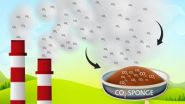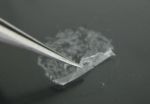(Press-News.org) SAN FRANCISCO, Aug. 10, 2014 — As the Food and Drug Administration (FDA) mulls over whether to rein in the use of common antibacterial compounds that are causing growing concern among environmental health experts, scientists are reporting today that many pregnant women and their fetuses are being exposed to these substances. They will present their work at the 248th National Meeting & Exposition of the American Chemical Society (ACS), the world's largest scientific society.
The meeting, which takes place here through Thursday, features nearly 12,000 presentations on a wide range of science topics.
"We looked at the exposure of pregnant women and their fetuses to triclosan and triclocarban, two of the most commonly used germ-killers in soaps and other everyday products," says Benny Pycke, Ph.D. "We found triclosan in all of the urine samples from the pregnant women that we screened. We also detected it in about half of the umbilical cord blood samples we took, which means it transfers to fetuses. Triclocarban was also in many of the samples."
The problem with this, explains Pycke, a research scientist at Arizona State University (ASU), is that there is a growing body of evidence showing that the compounds can lead to developmental and reproductive problems in animals and potentially in humans. Also, some research suggests that the additives could contribute to antibiotic resistance, a growing public health problem.
Although the human body is efficient at flushing out triclosan and triclocarban, a person's exposure to them can potentially be constant.
"If you cut off the source of exposure, eventually triclosan and triclocarban would quickly be diluted out, but the truth is that we have universal use of these chemicals, and therefore also universal exposure," says Rolf Halden, Ph.D., the lead investigator of the study at ASU.
The compounds are used in more than 2,000 everyday products marketed as antimicrobial, including toothpastes, soaps, detergents, carpets, paints, school supplies and toys, the researchers say.
Showing what effect antimicrobials have on people is a challenge. But Halden and Pycke's colleague Laura Geer, Ph.D., of the State University of New York, found at least one interesting result. Geer says the study yielded a link between women with higher levels of another ubiquitous antimicrobial, butyl paraben, which is commonly used in cosmetics, and shorter newborn lengths. The long-term consequences of this are not clear, but Geer adds that, if this finding is confirmed in larger studies, it could mean that widespread exposure to these compounds could cause a subtle but large-scale shift in birth sizes.
State policymakers, the FDA and industry have taken notice of the mounting evidence against triclosan. Minnesota became the first state to pass a ban on the antimicrobial's use in certain products, and it will take effect in January 2017. Some companies, such as Johnson & Johnson and Procter & Gamble, have announced that they are phasing out the compound from some products. At the federal level, the FDA and Environmental Protection Agency are reviewing the use and effects of the compounds.
INFORMATION:
A press conference on this topic will be held Tuesday, August 12, at 2:30 p.m. Pacific time in the Moscone Center, North Building. Reporters may report to Room 113 in person, or access live video of the event and ask questions at the ACS Ustream channel ACS Ustream channel.
Pycke, Halden and Geer acknowledge funding from the National Institute of Environmental Health Sciences and the New York Community Trust.
The American Chemical Society is a nonprofit organization chartered by the U.S. Congress. With more than 161,000 members, ACS is the world's largest scientific society and a global leader in providing access to chemistry-related research through its multiple databases, peer-reviewed journals and scientific conferences. Its main offices are in Washington, D.C., and Columbus, Ohio.
To automatically receive news releases from the American Chemical Society, contact newsroom@acs.org.
Note to journalists: Please report that this research is being presented at a meeting of the American Chemical Society.
Follow us: Twitter | Facebook
Title
Human biomonitoring of prenatal exposure to triclosan and triclocarban in a multiethnic urban population from Brooklyn, New York
Abstract
Triclosan (TCS) and triclocarban (TCC) are antimicrobial agents formulated in a wide variety of consumer products (including soaps, toothpaste, medical devices, plastics, and fabrics) that are regulated by the U.S. Food and Drug Administration (FDA) and U.S. Environmental Protection Agency. In late 2014, the FDA will consider regulating the use of both chemicals, which are under scrutiny regarding lack of effectiveness, potential for endocrine disruption, and potential contribution to bacterial resistance to antibiotics. Here, we report on environmental exposure to TCS and TCC based on actual consumer use of antimicrobial household products during pregnancy. Using liquid chromatography tandem mass spectrometry, we determined the concentrations of TCS, TCC, and its human metabolites (2'-hydroxy-TCC and 3'-hydroxy-TCC) as well as the manufacturing byproduct (3'-chloro-TCC) as total (Σ-) concentrations in maternal urine and cord blood plasma from a cohort of 181 expecting mother/infant pairs in an urban multiethnic population from Brooklyn, NY recruited in 2007-'09. Σ-TCS was detected in 100% of urine and 51% of cord blood samples. The interquartile range of detected Σ-TCS concentrations in urine were highly similar to those reported previously for the age-matched population of the National Health and Nutrition Examination Survey (NHANES) from 2003/4, but typically higher than those reported for the general population (detection frequency = 74.6%). Urinary levels of Σ-TCC are reported here for the first time from real-world exposures during pregnancy, showing a median concentration of 0.21 µg/L. Urinary concentrations of ∑-TCC correlated with its phase-I metabolite ∑-2'-hydroxy-TCC (r = 0.49) and the manufacturing byproduct ∑-3'-chloro-TCC C (r = 0.79); and ∑-2'-hydroxy-TCC correlated with ∑-3'-hydroxy-TC (r = 0.99). This study presents the first human biomonitoring data for TCC based on actual consumer exposures during pregnancy and provides additional data for environmental exposure to TCS in the maternal-fetal unit for an urban population in the United States.
Pregnant women and fetuses exposed to antibacterial compounds face potential health risks
2014-08-10
ELSE PRESS RELEASES FROM THIS DATE:
Wine symposium explores everything you wanted to know about the mighty grape (video)
2014-08-10
San Francisco, Aug. 10, 2014 — Location. Location. Location. The popular real estate mantra also
turns out to be equally important for growing wine grapes in fields and storing bottles of the beverage at home or in restaurants, according to researchers.
Those are just two of the topics that will be covered in a symposium titled, "Advances in Wine Research," that will run today through Tuesday at the 248th National Meeting & Exposition of the American Chemical Society (ACS). The meeting features nearly 12,000 reports. A brand-new ACS video on the topics is available ...
Carbon dioxide 'sponge' could ease transition to cleaner energy
2014-08-10
SAN FRANCISCO, Aug. 10, 2014 — A sponge-like plastic that sops up the greenhouse gas carbon dioxide (CO2) might ease our transition away from polluting fossil fuels and toward new energy sources, such as hydrogen. The material — a relative of the plastics used in food containers — could play a role in President Obama's plan to cut CO2 emissions 30 percent by 2030, and could also be integrated into power plant smokestacks in the future.
The report on the material is one of nearly 12,000 presentations at the 248th National Meeting & Exposition of the American Chemical Society ...
On the frontiers of cyborg science
2014-08-10
SAN FRANCISCO, Aug. 10, 2014 — No longer just fantastical fodder for sci-fi buffs, cyborg technology is bringing us tangible progress toward real-life electronic skin, prosthetics and ultraflexible circuits. Now taking this human-machine concept to an unprecedented level, pioneering scientists are working on the seamless marriage between electronics and brain signaling with the potential to transform our understanding of how the brain works — and how to treat its most devastating diseases.
Their presentation is taking place at the 248th National Meeting & Exposition of ...
Like cling wrap, new biomaterial can coat tricky burn wounds and block out infection
2014-08-10
SAN FRANCISCO, Aug. 10, 2014 — Wrapping wound dressings around fingers and toes can be tricky, but for burn victims, guarding them against infection is critical. Today, scientists are reporting the development of novel, ultrathin coatings called nanosheets that can cling to the body's most difficult-to-protect contours and keep bacteria at bay.
The researchers are speaking about their materials, which they've tested on mice, at the 248th National Meeting & Exposition of the American Chemical Society (ACS), the world's largest scientific society.
The meeting features ...
Women who 'lean in' often soon leave engineering careers, study finds
2014-08-09
WASHINGTON –- Nearly 40 percent of women who earn engineering degrees quit the profession or never enter the field, and for those who leave, poor workplace climates and mistreatment by managers and co-workers are common reasons, according to research presented at the American Psychological Association's 122nd Annual Convention.
While women accounted for more than 20 percent of engineering school graduates over the past two decades, only 11 percent of practicing engineers are women, and only 9 percent of electronic and environmental engineers are, said Nadya Fouad, PhD, ...
Happier consumers can lead to healthier environment, research reveals
2014-08-09
WASHINGTON -- The pursuit of true happiness can lead people to lifestyles that will not only be satisfying but will be better for the environment, according to an overview of psychological research presented at the American Psychological Association's 122nd Annual Convention.
"For decades, consumerism has been on a collision course with the environment, with consumer appetites draining the planet of natural resources and accelerating global warming. One view is that we need to change consumption in order to save the planet," said Miriam Tatzel, PhD, of Empire State College. ...
Trauma before enlistment linked to high suicide rates among military personnel, veterans
2014-08-09
WASHINGTON -- High rates of suicide among military service members and veterans may be related to traumatic experiences they had before enlisting, making them more vulnerable to suicidal behavior when coping with combat and multiple deployments, according to the findings of several recent studies presented at the American Psychological Association's 122nd Annual Convention.
Experiencing child abuse, being sexually victimized by someone not in the service and exhibiting suicidal behavior before enlisting are significant risk factors for service members and veterans who ...
Regular marijuana use bad for teens' brains
2014-08-09
WASHINGTON –- Frequent marijuana use can have a significant negative effect on the brains of teenagers and young adults, including cognitive decline, poor attention and memory, and decreased IQ, according to psychologists discussing public health implications of marijuana legalization at the American Psychological Association's 122nd Annual Convention.
"It needs to be emphasized that regular cannabis use, which we consider once a week, is not safe and may result in addiction and neurocognitive damage, especially in youth," said Krista Lisdahl, PhD, director of the brain ...
Individual genotype influences effectiveness of HIV vaccine
2014-08-09
Almost 40 million people worldwide live with HIV/AIDS. Despite great effort, HIV-1 vaccine development has been challenging. A recent HIV vaccine trial, known as RV144, revealed that a combination of 2 vaccines protected some individuals from HIV infection. Individuals in the trial that made antibodies that bound to a specific region of the HIV envelope protein had a decreased risk of HIV infection. A new study in the Journal of Clinical Investigation reveals that an individual's genotype correlates with their ability to develop immunity to HIV in response to vaccination. ...
Improving lymphatic function protects mice from experimental colitis
2014-08-09
Chronic inflammatory bowel disease can be painful and debilitating. Both genetics and environment are thought to promote disease, but it is not fully understood how chronic IBD develops. Emerging evidence indicates that IBD is associated with an increase in lymphatic vasculature, which transports lymph throughput the body. It is not clear if these lymphatic vessels promote or improve IBD. A new study in the Journal of Clinical Investigation indicates that improving lymphatic function relieves experimental IBD in mice. Silvio Danese and colleagues at Humanitas Clinical and ...


